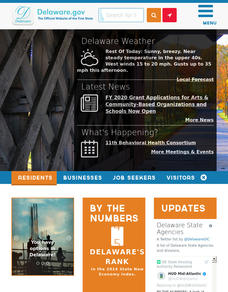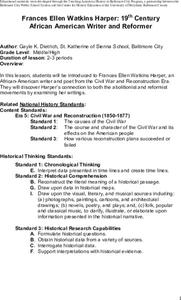Curated OER
A Brief History of Women in America
The story of women throughout American history is fascinating. Travel the path from domestic slave to the modern day with advocates such as Susan B. Anthony, the Grimké Sisters, and Gloria Steinem. A wonderful presentation that shows how...
Curated OER
Movement and Music: An Introduction to Slavery
Students create a slavery timeline. They identify key leaders in the anti-slavery movement. Students are asked what they can recall about slavery. They review the following vocabulary words slavery, spirituals, abolitionists, and...
Curated OER
Children's Attitudes about Slavery and Women's Abolitionism as Seen through Antislavery Fairs
Learners examine attitudes of children from the North growing up during the time of slavery. Using documents, they discover how abolitionists tried to change people's ideas of using slaves. They explore how women used antislavery fairs...
Curated OER
Causes of the Civil War
Seventh graders identify and discuss the causes of the Civil War. They define the vocabulary terms-Civil War, economy, plantations, abolitionist, secede, and slave; read and discuss reading passages about the Civil War, and answer...
Heritage Foundation
Slavery and the Constitution
It's hard to believe the abolition movement was once seen as scandalous. Help learners understand how the US Constitution changed everything. A variety of activities such as corresponding reading activities, group work ideas, and...
Curated OER
Literature for Lesson 4 - Abolitionists
Students examine the definition of abolition and abolitionists. In this abolition instructional activity, students complete vocabulary work before reading about Harriet Tubman, Sojourner Truth, and Frederick Douglass. They watch a video...
Curated OER
Abolitionists
For this online interactive history worksheet, students respond to 14 multiple choice, matching, and true/false questions about American abolitionists. Students may check some of their answers on the interactive worksheet.
Curated OER
The Abolitionist Movement
Eleventh graders examine a petition presented by the Quakers to the Delaware General Assembly in 1785 and an anti-slavery broadside published in 1836.
Curated OER
Slavery and Abolition: Three Unforgettable Names
Students research the people and events involved in the abolitionist movement prior to the U.S. Civil War. They read about and discuss the roles of Nat Turner, Harriet Tubman, and John Brown. Students complete a word splash, Venn...
Curated OER
Abolitionists Worksheet
A table with abolitionists Harriet Tubman, Frederick Douglass, and William Lloyd Garrison provides space to note the race, motivation, and accomplishment of each. Scholars are instructed to write a paragraph about one they'd like to meet...
National Endowment for the Humanities
David Walker vs. John Day: Two Nineteenth-Century Free Black Men
What was the most beneficial policy for nineteenth-century African Americans: to stay in the United States and work for freedom, or to immigrate to a new place and build a society elsewhere? Your young historians will construct an...
West Virginia Department of Education
History Scene Investigators - John Brown's Raid
An informative resource covers the event of John Brown's Raid, an event that became an important part of West Virginia history. It serves as a standalone and covers the event and John Brown's life in depth using group work, online...
Curated OER
The Kansas-Nebraska Act of 1854: Popular Sovereignty and the Political Polarization over Slavery
Why did Stephen Douglas support the Kansas-Nebraska Act of 1854? Why did Abraham Lincoln oppose it? Young historians examine how the Kansas-Nebraska Act of 1854 affected the political balance between free and slave states and explore how...
Crafting Freedom
Man in the Middle: Thomas Day and the Free Black Experience
How did free and enslaved blacks work to craft freedom for themselves and their families before the Civil War? Young historians read about the life of Thomas Day, a free black man who also owned slaves and had abolitionist ties in...
Curated OER
Civil War and Beyond
Sixth graders play a game. For this Civil War lesson, 6th graders discuss the beginnings of the Civil War and define vocabulary words associated with the war such as abolitionist and Emancipation Proclamation. Students play a game of...
Center for History Education
Frances Ellen Watkins Harper: 19th Century African-American Writer and Reformer
Although some African American abolitionists—such as Sojourner Truth and Frederick Douglass—are well known, others, like Frances Ellen Watkins Harper, remain in the shadows of history. Harper was a poet and activist who played an...
Center for History Education
Speaking Up and Speaking Out: Exploring the Lives of Black Women During the 19th Century
Young historians investigate the often-hidden history of free and enslaved African American women before the Civil War. Using a collection of primary and secondary sources, including speeches, diaries, and poems, they evaluate the often...
Curated OER
Free African-Americans in Delaware
Students work in groups of two and review the Abolitionist Movement. They observe the manumission/city directory and discover what it is and why it is so important. They read the manumission aloud and discuss why they were freeing their...
Curated OER
Harriet Tubman and the Underground Railroad
Students develop computer research skills while searching facts about Harriet Tubman. Students learn about ways in which Harriet Tubman's childhood influenced her future. Students learn to use primary documents to learn about the...
Curated OER
Two Views of the Slave Ship Brookes
Actual ship diagrams and a table of voyage data gives young historians an authentic glimpse of on-board experiences during the Atlantic Slave Trade. The class examines a projected diagram of the slave ship Brooks, recording thoughts....
Curated OER
1856-1865: Abolitionists and the Civil War
Middle schoolers discover philanthropic acts of the Civil War era. For this service learning lesson, students research Underground Railroad literature, Reconstruction Amendments, and acts of philanthropy during the Civil War era.
Curated OER
Abolitionists in U.S. History
Students read and discuss excerpts from the writings of Henry David Thoreau, Frederick Douglass and Sarah Parker Redmond. They compare and contrast the views of the three abolitionists concentrating on the experiences and reasons for...
Curated OER
Examining the Ties Between Abolitionism and the Women's Rights Movement
Students examine the historical link between the abolition and women's movements. After a brief introduction and mini-lecture, students work in pairs or small groups to complete a web quest to answer instructor provided questions...
K12 Reader
Uncle Tom’s Cabin: George’s Speech
Sometimes it takes a work of fiction to demonstrate nonfictional tragedies and events. George, an escaped slave, describes to Mr. Wilson the hardships of his life in a short passage from Harriet Beecher Stowe's novel, Uncle Tom's Cabin.
Other popular searches
- Abolitionist Movement Goals
- Abolitionist Movement Kwl
- Abolitionist Movement Kl
- The Abolitionist Movement

























